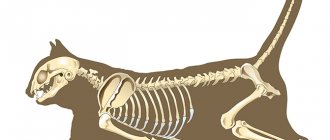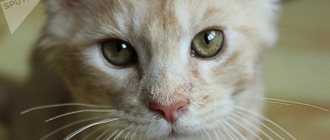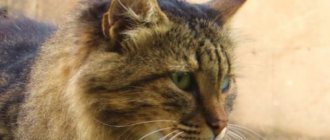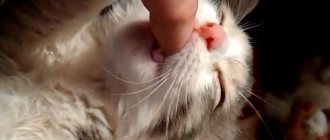Attentive pet owners do not lose sight of even the slightest behavioral features of their charges. Many people are interested in the question of why a cat sometimes jerks its tail, making sudden movements in different directions. This is due to various reasons. The tail is the most mobile part of the animal's body, consisting of many vertebrae. The functions it performs include the expression of the cat’s feelings and emotions.
Causes
Feline hyperesthesia syndrome affects the skin as well as the neuromuscular and nervous systems. Unfortunately, experts are not entirely sure what may be causing this rare disease.
Some experts believe there may be a connection between epilepsy and hyperesthesia, or that dry, itchy skin caused by a deficiency of omega-3 fatty acids in the diet may contribute to symptoms. Others suggest that it is a form of obsessive-compulsive disorder or that it may be a result of the cat being stressed.
Why does a cat twitch its tail?
To understand what this pet behavior expresses, you need to pay attention to the direction in which the tail moves. The environment in which the cat is located is also important. With the help of his tail, he tries to express his emotions, which are both negative and positive:
- Anxiety. The tail moves sharply in the horizontal plane. The flattened ears confirm the uncomfortable state of the animal, experiencing dissatisfaction and fear. In a panic, a cat is unpredictable, so you should eliminate the cause - take the animal away from the irritating object. A tail swaying to the sides is a sign that the pet is busy hunting and preparing to attack. In nature, this can often be observed when large wild cats are about to attack prey. Pets behave in the same way when playing with an inanimate object.
- Doubt. The need to make one choice or another is often another reason why a cat shakes its tail. The behavior of these animals has a lot in common with humans. Living nearby for thousands of years has brought certain results. While thinking about something, a person may involuntarily shake his leg or tap his fingers on the table. The cat, faced with a choice, rhythmically twitches its tail. At the same time, there are no other signals indicating his concern or anxiety. It is enough to help the animal make a decision, and the process will stop.
- Satisfaction. A cat can also express positive feelings using its tail. The animal conveys a feeling of calm and happiness by twitching the tip of its tail. When showing tender feelings towards a pet, stroking and scratching, this can be observed constantly. The cat expresses reciprocal feelings by purring and lightly twitching its tail. This means that everything that happens gives him satisfaction.
- Interest. This is also a common reason why a cat's tail twitches. At the same time, their movements are performed rhythmically and slowly. The pet's state is relaxed, all attention is focused on any one object. The cat can walk around it, peering with caution, sniffing and examining it. A cat's curiosity manifests itself in a similar way when the owner brings home a bag of groceries.
When trying to understand the state of a pet by twitching its tail, it is necessary to take into account the environment and other signals given by the animal.
Symptoms
Symptoms of feline hyperesthesia can develop at any age, and the condition can occur in all breeds. A cat that suffers from hyperesthesia syndrome may end up licking and biting its own body, such as its limbs, tail and back.
Expert opinion
Slanimsky Alexey Georgievich
Veterinarian of the highest qualification category. Has extensive experience in diagnosing and treating diseases in animals.
Important! It is still not known for certain why this disease occurs, but it regularly burns nerve cells for cat breeders. As a rule, the manifestations of this pathology can be managed with sedatives, which your veterinarian can prescribe to the cat.
Here are some other signs that your cat may have hyperesthesia:
- The skin on your cat's back may range from the shoulders to the tail
- Your cat may suddenly jump and turn towards her tail as if something is bothering her
- You may notice muscle twitching, tail twitching, and/or muscle spasms
- Your cat may not like certain areas of its back to be touched when you go to pet it
- Your cat may act erratically, appear agitated, and have dilated pupils
- Your cat may cry, hiss, or suddenly run away, and you may think she's hallucinating because she looks like she's going after something that isn't there.
- Severe cases can lead to self-destruction through chewing, licking, fur pulling, and biting. As a result, lesions and infections may appear on the skin.
Typically, these symptoms occur in episodes that may last only a few seconds or a few minutes. In between episodes, your kitten will act as if everything is fine. However, touching your cat in the wrong place can trigger an episode.
Causes of tail shaking
Not only cats, but also cats can mark territory by shaking their tail.
Tails are considered an ornament for pets, especially long-haired ones. This is an important part of the body, thanks to which animals are able to land on their paws when jumping from a height. Tails help to maintain balance and walk on thin bars. At the same time, it is an indicator of the emotional and physical state of kittens and adults. The strange behavior of a pet can be easily understood by observing the movements of its tail. If he twitches and shakes sharply, it means that the pet is dissatisfied with something. There are several reasons why an animal nervously shakes its tail or finely shakes its tip.
Interest
Often such movements of this part of the body are characteristic of animals engaged in observation.
A curious kitten or adult pet shows interest by staring or continuously observing a place or living thing. At this time, the cat twitches its tail, but does it constantly, slowly, calmly. In general, this position indicates concentration or relaxation with a degree of interest. A striking example is the owner returning home in the evening with a bag of groceries when the cat is waiting for him at the door.
Satisfaction
If a kitten or an adult cat's tail twitches frequently, this can be perceived as irritation, although this sign indicates satisfaction. This is how cats behave when they are happy with what is happening around them, with food, and with attention from their owner. The movement of the tail is complemented by purring. If a pet behaves this way, then its owner also has nothing to worry about.
Marks territory
By performing such an action, the fluffy wants to show that he is the owner of this territory.
Marking an area or a specific object is important in the life of every pet. This is how in the animal world there is an appropriation of territory, a declaration of one’s rights, a division of possessions between cats, and an exchange of information. The cat shakes its tail very finely when it marks the selected object, while pointing its tail upward. There are cats that do the same procedure. It looks the same as cats do, with the only exception that the marks are made with urine. If for the former this is typical behavior of a male, then in the second case it is the animal’s way of relieving stress. To get rid of the troubles associated with the private behavior of a pet, it is castrated. It is recommended to carry out the procedure while the animal is young.
Expressing doubt
Just like a person, a cat can be faced with a choice. At the same time, the pet’s tail shakes and spins in different directions chaotically. The animal does not show any emotions either with its body or sounds. This behavior means that the pet does not know what to do. Perhaps he does not understand what is happening and he needs the owner’s help in explaining the current situation.
Anxiety
This movement of the bone process can be observed in a pet that has gone hunting.
During times of tension, fear, or extreme alertness, the cat jerks its tail from side to side horizontally. This suggests that the animal accepts the challenge and will not only defend itself, but is also ready to attack. The pet may have an arched back, as if from fear, but more often it presses slightly to the ground. An example of this behavior is hunting or playing, when the cat presses its ears and constantly twirls its tail.
Treatment
If your kitten begins to show signs of feline hyperesthesia syndrome, it is a great idea to talk to your veterinarian, who will evaluate your pet and rule out other problems that have similar symptoms.
If hyperesthesia is the cause of your cat's symptoms, it is important to know that there is no definitive cure for this condition. Instead, your veterinarian may recommend giving your pet prescription medications such as anticonvulsants or antidepressants. Reducing your cat's stress and anxiety levels through environmental enrichment may also be helpful, or you may be advised to make changes to your kitten's diet. Additionally, natural remedies such as acupuncture, massage, and supplements may also be recommended.
What other reasons for movement are there?
Tail movements indicate not only the mood of the pet, but also the state of its health. If the cat's behavior is unusual, you need to examine the animal and observe it.
If a cat shakes its tail, it means it is “speaking” and wants to be understood. There are a number of common “phrases” that are expressed by moving the tail:
Regularly repeated movements of this part of the body must be understood and carried out by the owner of what the furry is asking him to do.
- Playful mood - the tail is raised vertically and twitches easily.
- Irritation, reluctance to play anymore - the tail hits the floor.
- Nervousness, warning of a possible attack - the tail is raised, but its tip is bent.
- Stress - the cat's tail trembles when in a calm mood and meows. An animal may behave this way when sitting or lying down. In addition to emotions, this indicates pain and general malaise of the pet.
- An extreme degree of irritation, a harbinger of an attack - the tail is lowered and twitching, the animal purrs gutturally, the fur stands up.
Chaotic tail shaking can be a sign of serious illness in your pet. If, in addition to trembling of an incomprehensible nature, twitching of the hind legs is noted, you should consult a veterinarian. Common causes of this phenomenon are considered to be stressful situations, pinched nerve endings, and inflammation of the anal gland. Sometimes this is due to the discomfort caused by parasites or inflammatory formations that have arisen.
How cats communicate using their tail
In a cat society, the tail is simply irreplaceable. With the help of this part of the body, cats can express their attitude towards each other without uttering a sound.
The cat twitches its tail, and it is raised by a “pipe”
This is how the cat expresses pride in himself and his appearance. The cat feels confident in the circle of those present. Or the pet is very happy about the long-awaited meeting with the owners.
The tail is an indicator of the cat's emotions
Most often, a cat twitches its tail to communicate its mood. Depending on how and how actively she begins to move it, the owner can guess what emotions his pet is experiencing:
- Excess of feelings . Often a cat's tail twitches when a person pets the animal. Combined with purring, this means that the cat is absolutely happy. He is satisfied with the owner's attention and hurries to tell him about it.
- Interest in something . The cat's tail stands upright when the pet is happy and expects something pleasant (for example, it is time to feed). But when he begins to smoothly move it up and down, this is a sign that the cat is interested in some thing or object. He will walk around it, sniff it, try to catch it. It could be anything: a fly flying by, a new toy, a bag of groceries.
- Irritation . Experiencing such emotions, the cat begins to rhythmically jerk its tail left and right. This is how she shows that the current situation is unpleasant for her. For example, a pet may feel that the timing for affection is poorly chosen.
- Fear, panic . It is not difficult for a person to determine that a cat is very scared - the animal twitches its tail, hitting it on the floor with all its force. His whole body is shaking, his pupils are dilated, and the cat itself can make plaintive sounds. At such moments, the pet should not be touched. The best thing the owner can do is to eliminate the situation or object that frightened the animal.
A small kitten often jerks its tail upward when it wants to play, run, or catch mice. Twitching is accompanied by the baby jumping on the owner's legs and various objects in the house. This is the most active age of a cat, and she encourages the owner not to forget about her needs.
The cat is shaking its tail: what is its mood?
Like people, cats have a body language that can be used to determine the animal’s state of mind. So, the owner, by looking at the cat, can understand whether the cat wants to play, or whether it is better to leave the pet alone.
- If a cat intends to play with a person, he expresses this with a slight twitch of his tail directed vertically upward. If during play the cat begins to loudly lash the floor with its tail, then everything should be stopped.
- A pet's irritation can be easily determined by the nervous twitching of its tail in different directions. Sometimes an indicator of an irritated state is a tail raised up, with its tip bent in a hook.
- Another reason for tail shaking is a feeling of stress, some fear. Your pet may be experiencing pain. If a cat is worried about something, it usually taps its tail on the floor with small shot, and the general appearance of the animal is full of thoughtfulness. To eliminate the possibility of your pet becoming ill, it is necessary to examine the animal as soon as possible and take appropriate measures.
- If the fur on the cat's back is tousled and the tail flicks from side to side, you must be careful and attentive when interacting with your pet, as the animal may suddenly attack.
Why do you need a tail: “fifth limb”
Observations of the graceful animal showed that the back part of its body has many functions:
- Steering wheel and stabilizer. When running, walking, jumping, climbing trees, swimming, a cat needs a tail to control and coordinate movements. It helps the dexterous animal keep its balance when walking along roof eaves, balcony railings, and fences. This is why a cat waves its tail during complex maneuvers.
- Fuse. When falling from a great height, the cat’s “balance beam” participates in creating the “parachute effect”, helping to turn over from any position with your back up, spread your outstretched paws wide, reduce the speed of the fall to 100 km/h (for humans - 210 km/h) and land safely . The “high altitude syndrome” purr was studied by veterinarian G. Robinson, physicist T. Kane, and mathematician R. Montgomery. With the advent of digital photography, scientists were able to see how a cat twitches its tail while “flying.” The research results have found application in sports and aerodynamics. They formed the basis of techniques that help fighters dodge blows and astronauts move in zero gravity.
- Heater. In an unheated room, the end part of the body serves as a fur collar for cats, saving them from the cold. The purrs cover their nose and paws with it, curling up into a ball. One of the rescue options.
- Organ of touch. Thanks to many sensitive hairs, the tail allows the cat to recognize objects, hug and stroke familiar brothers and owners.
- Communicator. Although a cat can convey a hundred intonations with its voice, it often speaks with its tail. Trainer Yu. Kuklachev interpreted 25 of his movements.
- Mood sensor. When a cat wags its tail, it not only communicates, but also expresses emotions.
- Marker-relaxator. On the back of the furry's body there are glands, the secrets of which he leaves on his favorite places and companions. These “chemical messages” establish the boundaries of the whisker’s “field of activity.” Marks bring self-soothing to the animal, give confidence, and help to assert itself.
Why cats are afraid of water, how to teach them to bathe
The above examples confirm the importance of the organ that completes the cat’s body and is called by felinologists the “fifth limb.” When deprived of it due to injury, burn or bite, the animal’s body tries to compensate for the lost functions.
However, during the adaptation period, the four-legged “disabled” person noticeably loses to his fellow tribesmen in dexterity and beauty of movements. In the naturally tailless Manx, the stabilizing role is played by the vestibular apparatus and developed long hind legs.
Why do cats shake their tail?
Watching the cat, breeders wonder why the cat develops new behavioral characteristics - the tail is shaking. To give an accurate answer, you need to understand the details of this phenomenon.
A restless cat holds his tail in a horizontal position. If a cat's tail occasionally trembles and he looks around in fear, with his ears pressed to his head, this indicates the animal's alertness. If there is an object of irritation in the room, then it should be removed from the cat’s field of view, otherwise the animal may panic, and the further outcome of the actions of a frightened animal is unpredictable.
Note! But if the tail sways from side to side, you need to be prepared for a sudden attack by your pet, however, such a command from a pet does not always foreshadow a threat. Similar habits can be observed while playing with an inanimate object. Cats, parading their ancestors, attack their toy.
Cats, like humans, can express doubt when they need to make a choice. Living for several thousand years side by side with people, the descendants of tigers began to adopt some of the habits of the supreme being. While in thought, a person can rhythmically tap his fingers on the table or swing his leg. Likewise, a cat, which is faced with a choice, begins to involuntarily twitch the tip of its tail; the pussy holds the base of the tail straight. Moreover, in such a situation, only the tail is involved, that is, no other peculiarities in the cat’s behavior are observed. To stop flinching, you just need to help your pet make a choice.
The cat also twitches its tail, expressing a feeling of satisfaction. When the cat is calm, fed, and happy, he slowly raises the tip of his tail up and down. Also, such behavior indicates reciprocal feelings for the owner’s affection, so a representative of the cat family expresses gratitude to a person, and the cat purrs and, perhaps, rubs against the owner’s hands, walks around the owner. In addition, by twitching its tail, the cat informs others that what is happening in the room completely satisfies it.
Often the reason for a wagging tail is interest. Movements of the tail are carried out slowly and to the beat, but the general appearance of the animal remains unchanged, all the cat’s attention is focused on one object. This usually happens after the owner goes to the store; in such a situation, the subject of the cat’s examination becomes a bag of food. A pet, showing interest in something, watches with caution, sniffs, carefully examines the object, sometimes engrossed in its occupation, and prevents the owner from passing.
Note! To accurately determine why your beloved cat's tail is shaking, you need to be attentive to details, namely, the environment in which the animal is located, the general appearance of the cat and the pet's surroundings at the moment.
How does a tail reveal your mood?
The sign language of animals is unusually developed. And if it’s not always possible to determine a pet’s mood by its face, then its tail gives it away. He will convey everything that the cat likes or dislikes with his condition.
- You can tell if a cat is in a playful mood if the tail twitches when held upright. When he begins to make sharp blows to the floor, this is a signal that it is time to stop the game.
- The irritated state of a pet can be determined by its tail jerking sharply from side to side. In some cases, a raised tail with a curved tip indicates that the cat is nervous.
- Feelings of pain and stress also often cause a cat to twitch its tail. She makes smaller movements with it, sometimes knocking on the floor.
- If the fur on the back rises along with the twitching of the tail, this means that the animal is in an extreme state of excitement and is capable of attacking.











